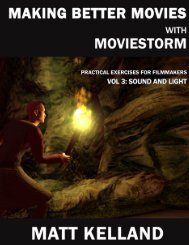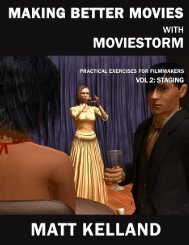Making Better Movies with Moviestorm Vol 1: Basic Camerawork
Making Better Movies with Moviestorm Vol 1: Basic Camerawork
Making Better Movies with Moviestorm Vol 1: Basic Camerawork
- No tags were found...
You also want an ePaper? Increase the reach of your titles
YUMPU automatically turns print PDFs into web optimized ePapers that Google loves.
STATIC VS MOVING CAMERASFirst film the scene using completely locked cameras. To give yourself maximum constraints, do not even allowyourself to pan or zoom: the framing must stay constant throughout. You can use extreme camera angles, as if youhad cranes or other equipment, but the camera must not move.Now film the scene again, but allow yourself full freedom of movement: you can pan, track, dolly, zoom, or anythingelse you want.ReviewHow does the camerawork affect the scene? What does the motion add to thescene? Is it distracting?When you‟re moving the camera, do the shots flow well together? Does thescene feel coherent, or is there a stop-start feel to it?Do you like your camera movements to go all the way from the beginning to theend of the cut, or do you prefer a pause before and after the movement? Inwhat circumstances would you use or not use a pause?How do the different constraints affect your cutting pattern (i.e. when do youuse a move instead of a cut to get to a new framing)? Do you still cut at thesame places?Do you have to change the staging between the two versions?How well can you cover actor movement when you can‟t move the cameras?What scenes work well for static cameras and which benefit from motion?How many setups would you need for the different versions? What kit would youneed?Follow-up exercisesRefilm the scene using very slowly moving cameras in place of the static ones from your first version, pushing in orpanning slightly. What difference does adding just this small amount of motion make?Add different music. How does this affect whether you prefer static or moving cameras, and the speed at which thecameras move?Film several scenes and ensure that the amount and style of movement in each is coherent and appropriate to thescene. They do not need to be the same, but they do need to go together successfully. For example, have twoconsecutive dialog scenes, then an action scene, and finally another dialog scene.8




